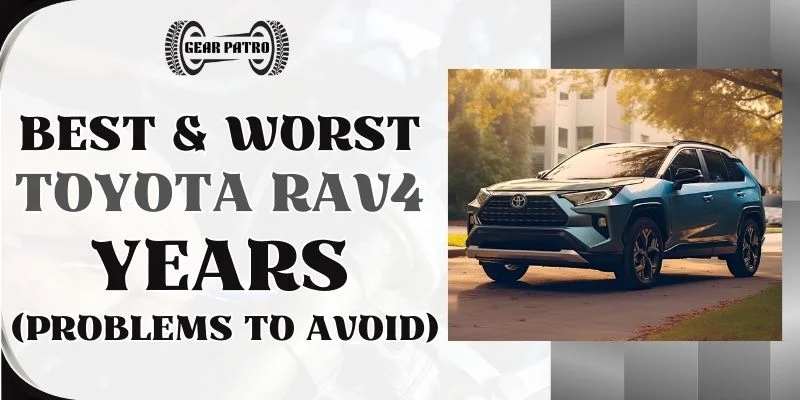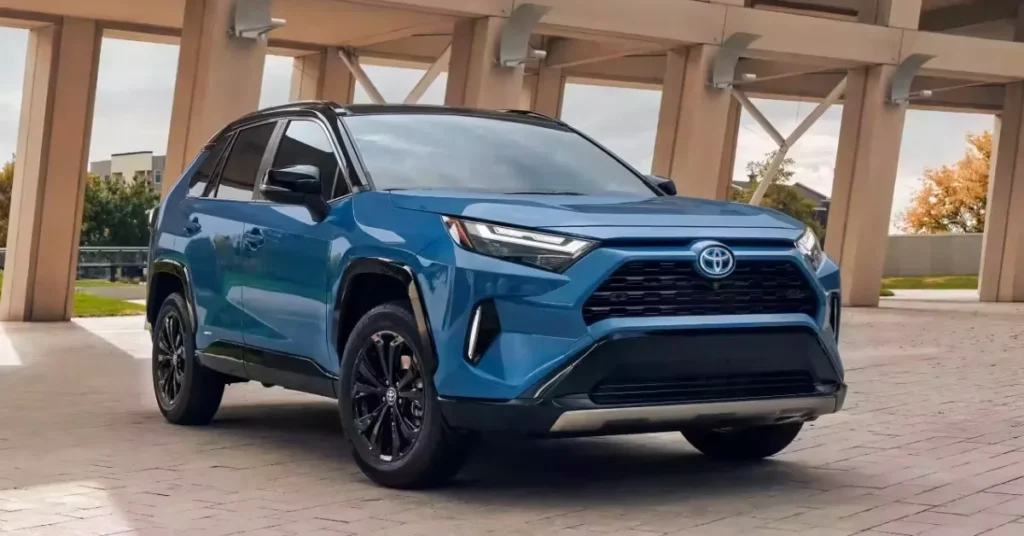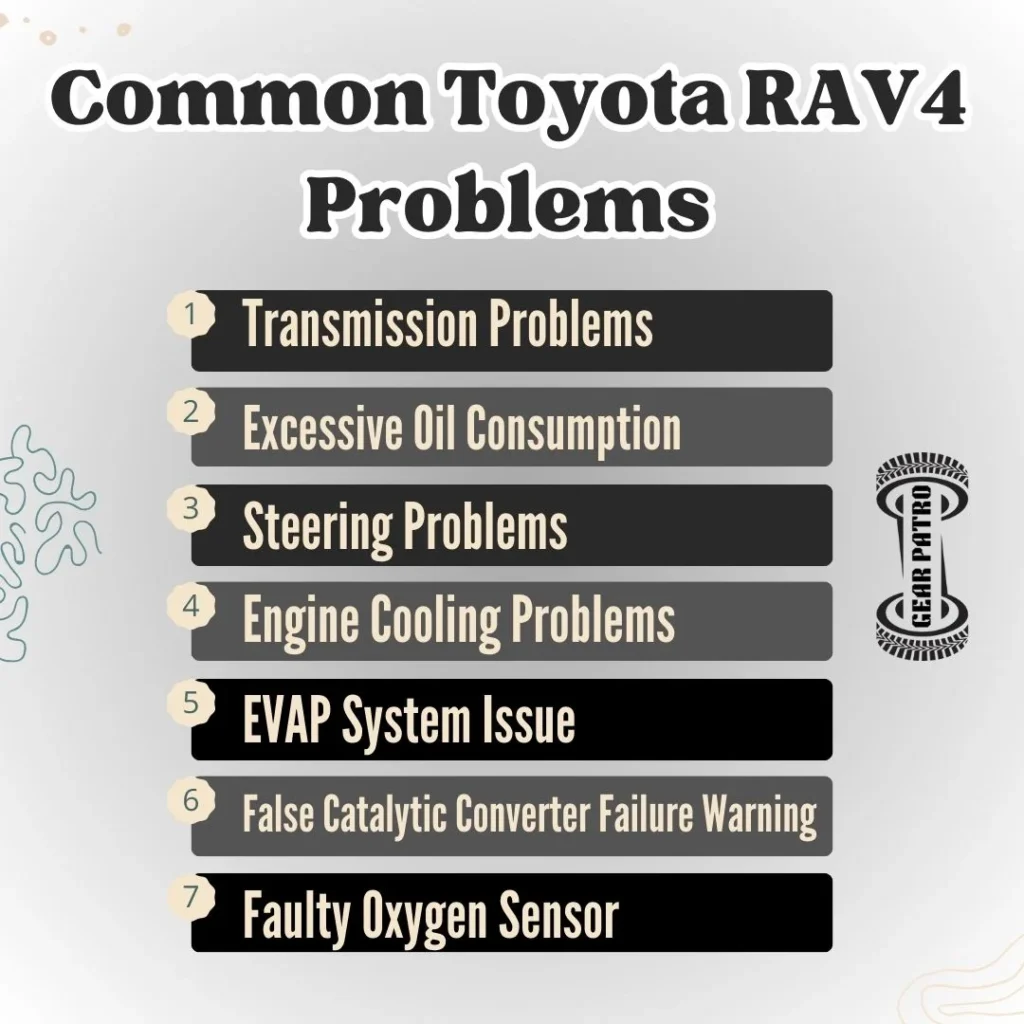When considering a Toyota RAV4, what model year should you buy? In order to help you make an informed decision, we’ve compiled the ultimate guide.
Obviously, every Toyota RAV4 model year is different.
Based on decades of experience and countless hours spent under the hood, we compiled a list of the best and worst model years.
Our review reveals everything you need to know about some models, from their admirable reliability to their unexpected shortcomings.

To begin with, let’s list the generations of the Toyota RAV4 based on their similarities.
Our next section will show you which Toyota RAV4 year is the best and which one you should avoid.
Let’s get started! The engines are revving!
Why Is The Toyota RAV4 So Popular?
There’s always been a perfect balance between car-like dynamics and SUV-like ruggedness in the RAV4. Also, being a Toyota isn’t a bad thing. Thousand of buyers instantly admired the first-generation model’s cute yet tough design. Three-door models of the first generation were particularly youthful in design.
There is no perfect car, but the RAV4 rarely requires extensive maintenance or is excessively expensive when it does. A typical annual repair cost for the RAV4 is $429, which is higher than the average for all compact SUVs. Moreover, the RAV4 doesn’t need frequent or extensive repairs.

A RAV4 has a great resale value as well. The Toyota RAV4 is one of only three SUVs with a slower depreciation rate after five years.
Although the RAV4 is a modern vehicle, it maintains a simple design even in its fifth generation. Rather than a turbocharged engine, the standard four-cylinder engine is non-turbo to prioritize safety.
Generations Of The Toyota RAV4
| Toyota RAV4 Generations | Model Years |
| Toyota RAV4 [5th generation] | 2019-present |
| Toyota RAV4 [4th generation] | 2013-2018 |
| Toyota RAV4 [3rd generation] | 2006-2012 |
| Toyota RAV4 [2nd generation] | 2001-2005 |
| Toyota RAV4 [1st generation] | 1996-2000 |
Our list of the best and worst Toyota RAV4 years for each generation is intended to help you determine which years to avoid and which to look for.
Our list also includes a neutral year. It is impossible to categorize these years as good or bad since we cannot categorize them on either side.
| Toyota RAV4 Generations | Best Years | Neutral Years | Worst Years |
| 1st generation | 1996 1998 | 1997 | 1999 2000 |
| 2nd generation | 2001 2004 2005 | 2002 2003 | |
| 3rd generation | 2009 2010 | 2008 2011 2012 | 2006 2007 |
| 4th generation | 2013 2015 2016 2017 2018 | 2014 | |
| 5th generation | 2022 2023 | 2019 2020 2021 |
Our combined score is used to categorize the models. Our score is determined by multiple factors, each of which has a specific weight. For the final decision, we will also use owner surveys along with quantitative data.
The following factors should be considered:
To estimate the car model’s reliability, weights are assigned to each factor, along with recall frequencies.
Best & Worst Years For Toyota RAV4 [5th Generation, 2019-Present]
In 2019, Toyota unveiled its fifth-generation RAV4 compact SUV with a rugged exterior and high-tech features that set new standards in the segment.
As a result of Toyota’s New Global Architecture (TNGA), the RAV4 has improved its ride quality, stability, and efficiency.
![Best & Worst Years For Toyota RAV4 [5th Generation, 2019-Present]](https://gearpatro.com/wp-content/uploads/2024/06/Best-Worst-Years-For-Toyota-RAV4-5th-Generation-2019-Present-1024x576.webp)
2022 And 2023 Are The Best Years
This generation’s standouts are Toyota’s RAV4 models for 2022 and 2023 in terms of safety and technology. There will be a plug-in hybrid option available on the 2022 model, as well as a more powerful and efficient hybrid system.
Additionally, the model 2023 offers an easier-to-use interface, a more sophisticated infotainment system, and improved connectivity.
The Toyota has always been committed to safety, so both years offered a wide range of driver-assistance systems, including collision warning, automatic emergency braking, and lane departure warnings as standard equipment.
2019 – 2021 Are The Worst Years
While the fifth generation introduced some innovations during its initial years – 2019, 2020, and 2021 – some teething problems were experienced. The new infotainment system has been reported to have connectivity issues and lack of intuitive controls.
Some RAV4 models of these years also suffered from harsh or uncertain shifting from their new eight-speed automatic transmission.
The advanced safety features and fuel-efficient engines of these models help them remain competitive despite these issues.
“Tech Trendery” explores the latest in tech. In our fast-paced world, keeping up with technology can be a challenge. From groundbreaking gadgets to innovative software, there’s always something new to learn. “Tech Trendery” is your go-to source for understanding these changes.
Best & Worst Years For Toyota RAV4 [4th Generation, 2013-2018]
A sleeker, more contemporary design was introduced in 2013 with the fourth generation of Toyota’s RAV4.
As well as enhanced ride comfort and fuel efficiency, the model also offers a range of advanced safety features that reflect Toyota’s commitment to driver safety and comfort.
![Best & Worst Years For Toyota RAV4 [4th Generation, 2013-2018]](https://gearpatro.com/wp-content/uploads/2024/06/Best-Worst-Years-For-Toyota-RAV4-4th-Generation-2013-2018.webp)
2013 To 2018, 2015 To 2016, 2017 To 2018 Were The Best Years
The 2013 model introduced a stylish new design, a fuel-efficient four-cylinder engine, and an automatic transmission that improved fuel efficiency.
This achievement has resulted in the 2015 RAV4 being equipped with a new technology package, including blind-spot monitoring and rear cross-traffic alert. On all 2016-2017 RAV4s, a pre-collision system with pedestrian detection was standard, as was adaptive cruise control.
It also introduced a sportier SE trim and a rugged-looking RAV4 Adventure in 2017 and 2018.
2014 Was The Worst Year Ever
Though the 2014 RAV4 was a success for the fourth generation, it was marred by a few key issues.
Infotainment systems and interior accessories were reported to be slow or unresponsive.
In spite of the engine and transmission still being reliable, the reported interior issues somewhat tarnished the reputation of this model year.
Best & Worst Years For Toyota RAV4 [3rd Generation, 2006-2012]
With the introduction of its third generation in 2006, Toyota’s RAV4 moved closer to midsize SUV territory.
The car also featured a newly designed exterior, a roomier interior, and the option of a powerful V6 engine as well as enhanced performance, comfort, and utility.
![Best & Worst Years For Toyota RAV4 [3rd Generation, 2006-2012]](https://gearpatro.com/wp-content/uploads/2024/06/Best-Worst-Years-For-Toyota-RAV4-3rd-Generation-2006-2012-1024x684.webp)
2009 And 2010 Were The Best Years
The 2009 and 2010 models exemplified the RAV4’s high point of development in this generation. In both years, exteriors were restyled, interiors were updated, and touchscreen navigation systems were optional.
As well as the V6 engine, Toyota provided its fuel-efficient and powerful V8 engine.
Consumers will also be able to select a vehicle that fits their lifestyles with the RAV4 Sport’s sport-tuned suspension and distinctive styling cues.
2008, 2011 And 2012 Were Neutral Years
For the RAV4, the 2008, 2011, and 2012 models weren’t spectacular, but they were fine. These models were not significant improvements over their predecessors, despite their competitive features and Toyota’s quality and reliability.
Their appeal remained as a result of the V6 engine and spacious interior.
2006 And 2007 Were The Worst Years
There were also some issues with the 2006 and 2007 models, despite their increased size and power.
A negative impact of oil consumption problems during these years was negatively reflected in the vehicle’s reputation, which negatively impacted sales.
The sales of these models were further dampened by some owners reporting transmission problems, particularly with shifting.
Best & Worst Years For Toyota RAV4 [2nd Generation. 2001-2005]
A larger, cozier interior and a refined layout marked the beginning of the second era of the Toyota RAV4.
Technology advancements and safety features were incorporated into a more mature and capable compact SUV.
In spite of remaining true to its roots, Toyota’s 2001 RAV4 demonstrated its commitment to keeping up with the rapidly evolving segment.
![Best & Worst Years For Toyota RAV4 [2nd Generation. 2001-2005]](https://gearpatro.com/wp-content/uploads/2024/06/Best-Worst-Years-For-Toyota-RAV4-2nd-Generation.-2001-2005.webp)
2001, 2004 And 2005 Were The Best Years
In the 2001 RAV4, consumers appreciated the stronger 2.0L four-cylinder engine. By 2004, anti-lock brakes and stability control systems were standard.
An advanced all-wheel drive system and a more powerful four-cylinder engine made the 2005 RAV4 one of the most comprehensive compact SUVs available.
2002 And 2003 Were The Worst Years
RAV4 models from 2002 and 2003 had some reliability issues. Due to transmission problems, especially with automatic transmissions, we recommend staying away from these models.
Though the car offered similar features to its predecessors and immediate successors, this model year’s mechanical problems proved to be a significant drawback.
Best & Worst Years For Toyota RAV4 [1st Generation, 1996-2000]
As the first compact crossover SUV capable of off-road driving, it provided a car-like driving experience. 1996 was the year Toyota introduced the RAV4.
Due to its distinctive two-door design, this innovative vehicle contributed to the development of the burgeoning segment through its combination of practicality, versatility, and style.
![Best & Worst Years For Toyota RAV4 [1st Generation, 1996-2000]](https://gearpatro.com/wp-content/uploads/2024/06/Best-Worst-Years-For-Toyota-RAV4-1st-Generation-1996-2000-1024x675.webp)
1996 And 1998 Were The Best Years
In 1996, the Toyota RAV4 introduced a new generation of compact SUVs with its car-like ride and choice of 2.0L or 1.8L engines.
In 1998, Toyota added anti-lock brakes to its RAV4 as well as restyled its headlights to reinforce its market leadership.
1997 Was The Neutral Year
1997 was a transitional year for the RAV4. The car combined the benefits of an SUV and car, as well as providing some incremental upgrades, including a new unibody design.
With the 2.0L four-cylinder engine, it also achieved a good balance between efficiency and performance. It wasn’t until the following year that Toyota was able to fix some reliability issues.
1999 And 2000 Were The Worst Years
While the RAV4’s core strengths remained, it was beginning to show its age as the SUV market grew rapidly.
In terms of technology and interior comfort, the vehicle lacked significant advancements compared to its emerging competitors.
During these model years, reliability issues were also a problem, particularly with the transmissions and engines.
What About The Brand-New RAV4?
The newest RAV4s will have the best feature content, making them the most desirable. It would be best if the infotainment interface were upgraded between 2022 and 2023.
There hasn’t been enough time to test these newest RAV4s for reliability, so we can’t say for certain yet. The 2023-2024 RAV4s have received very few complaints, although 195 2023 models have been recalled for leaking air from the tires due to allegedly damaged valve stems. Black wheels on 17-inch alloy models are affected by the problem.
Common Toyota RAV4 Problems
Toyota RAV4s are known to be reliable vehicles. According to gearfixup, the Toyota RAV4 has a 4.0 reliability rating. There have been several common problems with the Toyota RAV4 over the years:

Transmission Problems
You may have transmission problems if you have trouble shifting gears or the SUV jerks at low speeds. Newer models seem to have the most transmission issues, including the 2019.
Excessive Oil Consumption
This problem has plagued Toyota RAV4 models since 2005. Most SUV drivers complain that they burn more oil after 50,000 to 150,000 miles. The warranty of Toyota was extended as a result of this issue.
Steering Problems
Steering problems with the 2017 model year are relatively common, causing the wheel to lock up or pull to one side. Some owners heard knocking noises when turning the wheel.
Engine Cooling Problems
Coolant fluid leaks into an engine when its cooling system leaks, causing severe mechanical damage.
EVAP System Issue
EVAP vapor canisters with faulty evaporative systems (EVAP) often illuminate the check engine light on RAV4 models. A blockage of the vent valve may occur when charcoal pellets leak from the vapor canisters. In order to repair the canister system, all valves should be replaced. This issue only affects older RAV4 models.
False Catalytic Converter Failure Warning
Owners of the RAV4 were warned about possible catalytic converter problems by the computer. It turned out that Toyota provided a software update to fix the false alarm.
Faulty Oxygen Sensor
This sensor monitors and adjusts the mixture of air and fuel. When oxygen sensors fail, fuel economy will be reduced and emissions will increase. In the RAV4, oxygen sensors are faulty primarily as a result of wear and tear. Although sometimes they fail sooner than 100k miles, they are capable of lasting up to 100k miles. If you need to replace the sensor on your RAV4, make sure it is the right one.
Should You Buy A RAV4?
Safety and reliability are excellent attributes of the RAV4. It will be easy to pick one you will not be disappointed with if you follow the above guide.
It is true, however, that the RAV grew increasingly boring over time. Even with competitive technology on higher trim levels, it doesn’t seem to be much more than a mode of transportation.
Most people don’t need cars for anything more than transportation. In case you’re looking for something a little different, consider a first-generation RAV.
Best & Worst Toyota Camry Years | Years To Avoid
Best & Worst Toyota Tacoma Years | Years To Avoid
Best & Worst Toyota Highlander Years | Years To Avoid
Best & Worst Toyota Corolla Years | Years To Avoid
Best & Worst Toyota Sienna Years | Years To Avoid
Best & Worst Toyota Tundra Years | Years To Avoid
Best & Worst Toyota 4Runner Years | Years To Avoid
Best & Worst Toyota Sienna Years | Years To Avoid
Best & Worst Toyota Prius Years | Years To Avoid
Best & Worst Toyota Avalon Years | Years To Avoid
FAQs:
Which year Toyota RAV4 is reliable?
While not highlighted as extraordinary reliable in the guide, many RAV4s outside the problematic years have become more reliable in recent years. It is always a good idea to consider models from recent years outside the problematic range when looking for a reliable model.
What are the bad years of RAV4?
There are also several years to avoid, including the 2019 model with transmission and brake issues, the 2013 model with low-speed vibration issues, and the 2006-2008 RAV4s with serious engine issues and reliability issues.
What year RAV4 has transmission problems?
Transmission hesitancy and lurching have been reported in the 2019 Toyota RAV4, along with transmission slippage.
What are the biggest problems with the Toyota RAV4?
In 2009 to 2012, RAV4 models experienced unwanted acceleration, while in 2006 to 2008, excessive oil consumption was observed. The infotainment has been plagued with glitches since the 2019 model had transmission issues.
Are Toyota RAV4s typically reliable?
Yes, absolutely. In the U.S., the RAV4 is the best-selling non-truck vehicle thanks to Toyota’s reputation for reliability. There are, however, some model years that are less reliable than others. Make sure you do your research before buying a pre-owned RAV4.
How much does a used Toyota RAV4 typically cost?
The RAV4 was introduced in the U.S. nearly 30 years ago, but you don’t want an old one. In the 21st century, you can expect to pay about $7,000 for a 2005 RAV4 with 150,000 miles. If the vehicle has fewer miles, the costs will be higher. Late-model examples will be more expensive due to the volatile market conditions. Based on CoPilot Price Pulse, an average 2018 Toyota RAV4 costs $24,754. There is a 29% increase compared to a normal sale.
Is the Toyota RAV4 a good car to purchase?
Any Toyota RAV4 you choose, whether it’s new or used, will be a good choice. Pre-owned cars, no matter how good their reputation, always carry a risk, no matter how reliable they are.
Conclusion
Having examined the best and worst years of the Toyota RAV4, let’s hear your experiences with the vehicle. Are you the owner of a top-rated or lowest-rated year?
Share your stories with us so we can see how they match up with our findings. We would appreciate hearing about your experiences. Let’s keep the conversation going!
